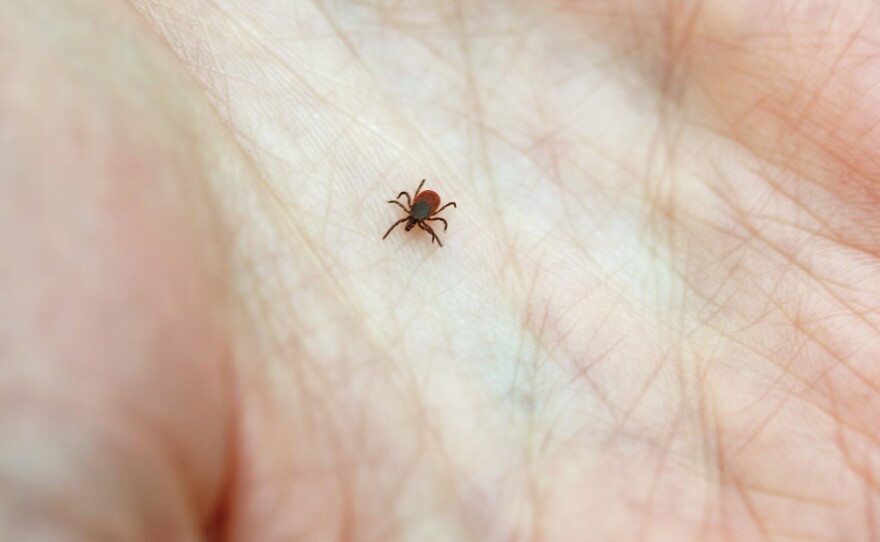This spring and summer may be a doozy for Lyme disease, at least in parts of the Northeast.
"We're anticipating 2017 to be a particularly risky year for Lyme," says Rick Ostfeld, a disease ecologist at the Cary Institute of Ecosystem Studies in Millbrook, New York.
Ostfeld has been studying the debilitating tick-borne disease for more than 20 years, and has developed an early warning system based on mice. For more on that, check out the piece in our sister blog, Goats and Soda.
He's not exactly sure which parts of the Northeast will be most affected, but if recent history repeats itself, the risk will be high in New York state and Connecticut, he says, and possibly patches of the mid-Atlantic region.
In other parts of the New England and the upper Midwest, Lyme continues to spread, says epidemiologist Kiersten Kugeler at the Centers for Disease Control and Prevention.
"Reported cases of Lyme have tripled in the past few decades," she says. "And today, we think that the true burden of Lyme disease in the U.S. is about 300,000 cases each year."
(Our global health team is reporting on the anticipated surge in Lyme disease as part of its series on future pandemics.)
Lyme disease — which causes flu-like symptoms and arthritis — is spread by blacklegged ticks. They can be as small a a poppy seed. And they like to hang out in the nooks and crannies of the human body. "That's the scalp, behind the ears, the armpits and in the groin area," she says.
On the East Coast, most people catch Lyme right around their homes, Kugeler says, not just when they're hiking or camping. "People may be putting themselves at risk every day without knowing it." Here are some tick bite-avoidance tips.)
So if you live in places with Lyme, she recommends checking your body for ticks every day. Make it part of your daily routine.
And when you find a tick:
1. Don't panic, says Dr. Brian Fallon, who directs the Lyme and Tick-Borne Diseases Research at Columbia University Medical Center.
2. Get out the tweezers. "Very carefully, go under the head of the tick with the tweezers and just pull out the mouth of the tick, which is embedded in the skin," Fallon says.
"What you don't want to do is squeeze the body of the tick," he says. "That will cause the tick to spew all of its stomach contents into the skin, and you'll be more likely acquire whatever infection that tick was carrying."
Also, don't put Vaseline or smoke from a cigarette or [a] match on it," Fallon says. "Just use tweezers."
3. Check the Lyme map. Next you want to figure out if you picked up the tick in an area where Lyme is a problem. The CDC tracks Lyme cases and has detailed statistics — at the county level — about where doctors report cases.
Another good place to check is the website of your state's health department.
The goal is to figure out if Lyme is present in your community. If the answer is, no, then you can relax. The chance you have Lyme is very, very low.
If the answer is, yes, then you want to see how intense transmission is in your county. This information will come in handy down at No. 5.
4. Save that tick. If there's a possibility you picked up the tick in an area where Lyme is common, Fallon says, you might want to hold onto the critter so a lab can test it for Lyme.
"Put the tick into a baggie," he says. "The tick doesn't even need to stay alive for a lab to see if it carried Lyme."
You can also take a picture of the tick and send it to the TickEncounter Resource Center. Scientists there will help identify the tick and tell you the chance it could have Lyme.
5. Monitor your health. So now comes the big decision: Should you go see a doctor? That depends on two factors: your symptoms and your location.
Be on the look-out for any red rash, Fallon says. It doesn't have to be shaped like a target or bull's eye.
"In fact, 80 percent of the time, the rash with Lyme isn't shaped like that. It's just red and expanding."
"If you do develop an expanding rash, a fever or flu-like symptoms, don't wait. Go see a doctor," Fallon says. The earlier you start taking antibiotics the more likely you will recover fully and not have any lingering problems.
And while some symptoms persist even when people get treated, "The good news with Lyme is the majority of people who get treatment early do very well," he says.
If you don't have any symptoms, you don't necessarily need to see a doctor, Fallon says. Not all blacklegged ticks have Lyme disease. And after it starts biting you, it takes about 24 to 36 hours to transmit the pathogen into your blood. So if the tick wasn't on your body very long, you're proabably OK.
But if you live in a place with a high number of Lyme cases, you might want to check in with a doctor even if you don't have symptoms, Fallon says, especially if you think the tick was on your body for a while.
"The Infectious Diseases Society of America recommends a one-day treatment of doxycycline, prophylactically," Fallon says, "That's believed to be protective, to some extent, from the disease."
Copyright 2017 NPR. To see more, visit http://www.npr.org/.






